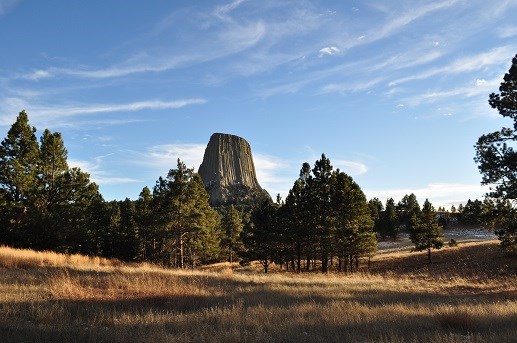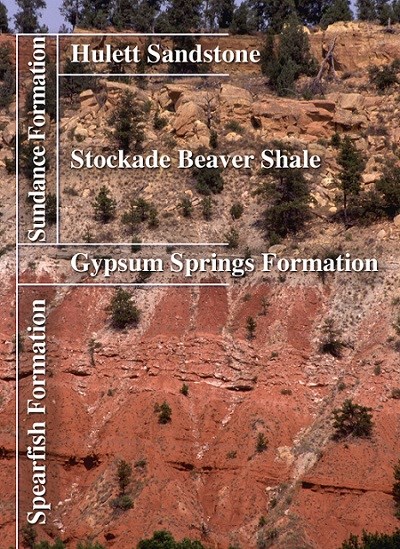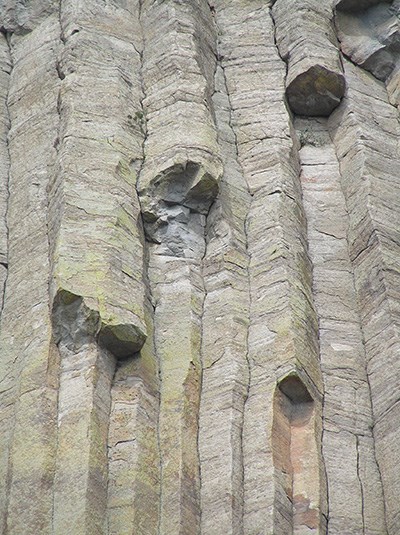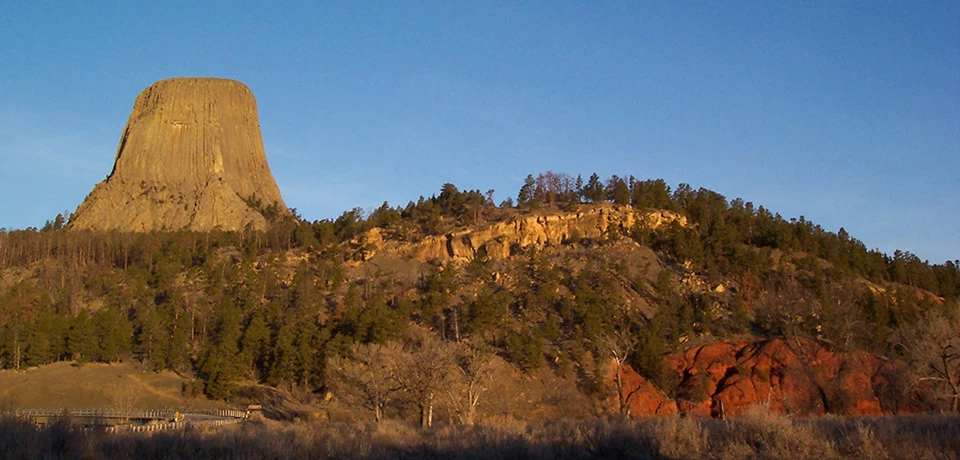
NPS / Stephanie Carter Devils Tower rises above the surrounding grassland and ponderosa pine forests like a rocky sentinel. Geologists have studied the formation since the late 1800s, and today still wonder how it formed. Although much of the Tower’s geologic story is agreed upon, theories differ on certain details. Protected in 1906 for its scientifc value, Devils Tower remains a place of scientifc study and public wonderment. We know that the Tower is formed of a rare igneous rock, phonolite porphyry, and is the largest example of columnar jointing in the world. To better understand processes which shaped the Tower, we look back through Earth's history to a time long before this unique feature took shape. 
NPS Building FoundationsMost of the landscape surrounding Devils Tower is composed of sedimentary rocks. These rocks are formed from solidification of minerals or organic material, and are usually deposited by water or wind. This process, known as deposition, is common in river deltas and coastal areas. Many fossils are found in sedimentary rocks, providing us with clues about ancient ecosystems. The oldest rocks visible in Devils Tower National Monument were deposited in a shallow inland sea. This sea covered much of the central and western United States during the Triassic period, 225 to 195 million years ago. Dark red sandstone and maroon siltstone, interbedded with shale, can be seen along the Belle Fourche River. Oxidation of iron-rich minerals causes the red color of the rocks. This rock layer is the Spearfish Formation. Above the Spearfish Formation is the Gypsum Springs Formation. As mineral rich water evaporated deposits of gypsum were left behind. During the Jurassic period (195 to 136 million years ago) seas periodically retreated and returned. Off-shore clay deposits in deep marine environments became gray-green shales interbedded with sandstones, limestones, and thin beds of red mudstone. These rock layers, called the Stockade Beaver Member, are part of the Sundance Formation—also of Jurassic age. The Hulett Sandstone and Lak Members, also part of the Sundance Formation, are yellow, fine-grained sandstones. Their origins trace back to sand deposited on an ancient beach, with many outcrops exhibiting preserved symmetrical ripples. Resistant to weathering, these form the nearly vertical cliffs that encircle the Tower itself. Seas retreated and advanced; landforms developed and eroded. New sediments were deposited. Approximately 50 to 60 million years ago, during Tertiary time, tectonic pressures within western North America climaxed, uplifting the Rocky Mountains and the Black Hills. At this time or shortly after, magma (molten rock) welled up toward the surface of the earth, intruding into the already existing sedimentary rock layers. 
Formation TheoriesGeologists agree that Devils Tower began as magma, or molten rock buried beneath the Earth’s surface. What they cannot agree upon are the processes by which the magma cooled to form the Tower, or its relationship to the surrounding geology of the area. Numerous theories have been suggested to explain how Devils Tower formed. Geologists Carpenter and Russell studied Devils Tower in the late 1800s and concluded that the Tower was formed by an igneous intrusion (the forcible entry of magma through other rock layers). Later geologists searched for more detailed explanations. The simplest explanation is that Devils Tower is a stock—a small intrusive body formed by magma which cooled underground and was later exposed by erosion (Figure 1). In 1907, scientists Darton and O’Hara decided that Devils Tower must be an eroded remnant of a laccolith. A laccolith is a large, mushroom-shaped mass of igneous rock which intrudes between the layers of sedimentary rocks but does not reach the surface. This produces a rounded bulge in the sedimentary layers above the intrusion (Figure 2). This idea was quite popular in the early 1900s when numerous studies were done on a number of laccoliths in the American southwest. Other ideas have suggested that Devils Tower is a volcanic plug or that it is the neck of an extinct volcano (Figure 3). The limited evidence of volcanic activity (volcanic ash, lava fows, or volcanic debris) in the area creates doubt that the Tower was part of a volcanic system. It is possible that this material may simply have eroded away. In 2015, geologist Prokop Závada and his colleagues proposed their own hypothesis for the formation of the Tower. They compared it to a similar butte formation in the Czech Republic. Their hypothesis suggests that the Tower is the result of a maar-diatreme volcano (Figure 4). These form when magma encounters groundwater beneath the Earth’s surface. The super-heated water becomes steam. This steam expands explosively creating a crater on the surface. The crater fills with lava which cools and solidifes into a dome structure. Erosion wears away portions of the dome to create the Tower as we see it today. The concept of erosion exposing the Tower is common to all of its modern formation theories. Ironically, the erosion which exposed the Tower also erased the evidence needed to determine which theory of Devils Tower’s formation is the correct one. 
NPS Columnar JointingThe columns of Devils Tower are its most striking feature. This appearance, known as columnar jointing, is not unique to the Tower. However, the size of the Tower's columns is unmatched. Soaring hundreds of feet into the air and stretching to 10 feet in width, the columns at Devils Tower are truly spectacular. Column formations occur only in igneous rocks. Igneous rocks originate from lava (on the Earth's surface) or magma (below the Earth's surface). As the molten rock cools from a liquid to a solid form, it begins to contract. This contraction stresses the cooling rock which begins to crack. Cracks radiate out from stress points, forming hexagonal (6-sided) shapes. Many examples of columnar jointing form perfect hexagons. The Tower columns are more irregular in shape, possibly because of their large size. There are also many 5-sided, or pentagonal, columns on the Tower. Scientists are uncertain what causes the variation in shape. The Tower columns are similar to those found elsewhere in the world, such as at Devils Postpile National Monument in California. However, the columnar jointing of Devils Tower is the largest and most spectacular example of this fascinating geologic phenomenon. Exposing the TowerErosion has dramatically changed the area around Devils Tower. When the Tower formed around 50 million years ago, it was one to two miles below the Earth’s surface. Somewhere between 5 and 10 million years ago, erosive forces began to expose the Tower. These forces, particularly that of water, carried away the sedimentary rocks above and around the Tower. The harder igneous rock of the Tower is more resistant to erosion, and the gray columns of Devils Tower began to stand out above the surrounding landscape. As rain and snow continue to erode the sedimentary rocks surrounding the Tower’s base, and the Belle Fourche River carries away the debris, more of Devils Tower will be exposed. At the same time, the Tower itself is slowly being eroded. The evidence of this process is seen in the large boulder field of broken columns at the base of the Tower, as well as many other rocks on the hillsides below the formation. Although small rocks fall from the Tower with regularity, no one has witnessed a significant column fall in recorded history. The geology of Devils Tower retains a bit of mystery for both casual visitors and scientific experts. Although many of the ideas surrounding its formation are understood, the wonder of this place is a quality that has captivated people for thousands of years and continues today. 
NPS |
An official website of the United States government
Here's how you know
Official websites use .gov
A
.gov website belongs to an official government
organization in the United States.
Secure .gov websites use HTTPS
A
lock (
) or https:// means you've safely connected to
the .gov website. Share sensitive information only on official,
secure websites.
